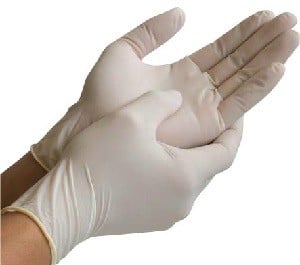Latex vs Nitrile vs Vinyl Gloves…Which to Choose?
When deciding between latex, nitrile and vinyl gloves…it can be a little confusing trying to determine which type of glove is the ideal choice. Let’s take a closer look at the attributes and benefits of each type of glove.
Latex Gloves
 Latex gloves are natural material, made out of rubber. They are a popular choice of protective glove for medical or industrial use. The primary reason people would choose an alternative to latex is because many people suffer from latex allergies. When allergy is not a concern, latex does have a slight advantage with comfort and dexterity over nitrile gloves.
Latex gloves are natural material, made out of rubber. They are a popular choice of protective glove for medical or industrial use. The primary reason people would choose an alternative to latex is because many people suffer from latex allergies. When allergy is not a concern, latex does have a slight advantage with comfort and dexterity over nitrile gloves.
Attributes include:
- Fit like a second skin
- Have a high level of touch sensitivity
- Are good for wearing for an extended amount of time
- Work well for high-risk situations involving infectious material
- Are cost-effective
- Are lightly powdered, making it easier to put on
- Are very elastic and strong
- Are biodegradable
Nitrile Gloves
 Nitrile gloves are made out of a synthetic rubber, and are an ideal alternative when latex allergies are of concern. Nitrile gloves are the superior glove when it comes to puncture resistance. Nitrile gloves are often referred to as “medical grade.” Before gloves can be marketed to hospitals and medical institutions, they must undergo a series of tests conducted by the Food and Drug Administration (FDA) to ensure their durability.
Nitrile gloves are made out of a synthetic rubber, and are an ideal alternative when latex allergies are of concern. Nitrile gloves are the superior glove when it comes to puncture resistance. Nitrile gloves are often referred to as “medical grade.” Before gloves can be marketed to hospitals and medical institutions, they must undergo a series of tests conducted by the Food and Drug Administration (FDA) to ensure their durability.
Attributes include:
- Latex-free
- Are most puncture resistant
- Have a high level of sensitivity
- Mold to your hand for a great fit
- Are good for wearing an extended amount of time
- Work well for high-risk situations involving infectious material
- Resist many chemicals
- Have a long shelf life
- Are available in blue or black to help identify if the glove has been punctured
Vinyl Gloves
 Vinyl gloves are a popular choice for the food industry and situations where high levels of durability and protection are less of a priority. While they may be less durable, they are the less expensive option.
Vinyl gloves are a popular choice for the food industry and situations where high levels of durability and protection are less of a priority. While they may be less durable, they are the less expensive option.
Attributes include:
- Latex-free
- Have a looser fit
- Are good for short-term, low-risk tasks
- Are the most economic option
- Have anti-static properties
- Are best for use with non-hazardous materials
- Are lightly powdered to make it easier to put on
So, when it comes time to decide which type of protective glove is the right choice for you, the most important thing to consider is….how much protection do you need?




